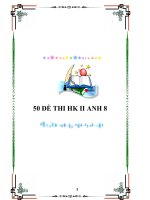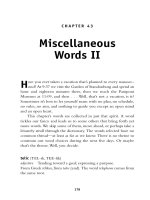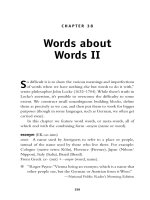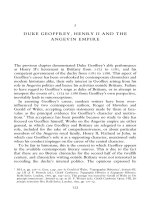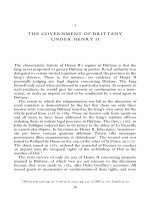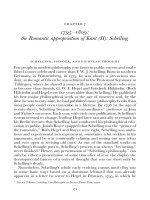Linguistics: Syntax II Movement Constraints
Bạn đang xem bản rút gọn của tài liệu. Xem và tải ngay bản đầy đủ của tài liệu tại đây (348.65 KB, 36 trang )
Linguistics: Syntax II
Movement & Constraints
2009
Phrases
• In the last lecture, we talked about simple
phrases; e.g. Noun Phrases like
– The dog
– The big dog
– The big dog that John was talking to
• In this lecture, we will look at how phrases and
larger objects are derived by rules, and how
phrases can be moved from one position to
another
– How structures and meanings (including ambiguity) are
mediated by syntax, particularly those “hidden”
structures that we don’t see or hear but actually use
– “John is easy to please” vs. “John is eager to please”
– Some basic rules and two case studies of hidden
structures that combine linguistics with psychology
Notations: Noun Phrase
Example
• Let’s talk about Noun Phrases (NPs) to begin with.
These have (among other properties) the following:
– The optional presence of an determiner (‘the’, ‘a’,
etc.)
– The optional presence of more than one adjective
• We can write a rule that generates NPs in the following
way:
NP --> (determiner) AP* N
This means that a noun phrase consists of minimally a head
N; it also can have
-an optional determiner (parentheses)
-any number of Adjective Phrases (AP), including zero
• From this rule, and rules that say ‘N-->cat,…’, A --> ‘big,
furry, irritable…’, we can generate a number of phrases
Examples
• From N --> (det) AP* N
NP
det
the
AP
AP
A
A
big
furry
N
cat
Adjuncts (are optional)
• We also need a way of adding adjoined
phrases like in [the cat [in the hat]].
• The PP here is adjoined, to “modify” the
meanings of the NP. The object that it is
attached to is still an NP.
• The rule that we can talk about is like this:
NP --> NP PP (the cat in the hat)
There are other options for this, but this will generate
the right structure, along with one more rule:
PP --> P NP (in the hat)
Verb Phrases
• We will also need rules to derive VPs
• Consider:
VP --> V NP
This says that a VP consists of a V and an NP
• This will define our set of transitive verbs: those
that have objects (more on this in a few slides)
• To be explicit, we could indicate this as
VP --> V-trans NP
Where
V-trans --> kick, hit, kill, ….
We want to exclude V’s like sleep, arrive, etc. from
this context
More Verb Phrases
• We can also have a PP adjunct to a verb
phrase; often these specify how the action was
performed, where it was performed, etc.
– Mary fixed the car with a wrench
– John kicked the ball in the garden
• A rule like the one that we employed above
will work here:
– VP --> VP PP
• VP--> V NP, NP->NP PP, VP->VP PP: this is
getting confusing
(Structural) Ambiguities
• Notice that both NPs and VPs can have PPs
attached to them
• In some cases, this results in what is called a
structural ambiguity: one string has more
than one structure associated with it, and
means different things depending on what the
structure is
• Example: I shot an elephant in my pajamas.
(How did it get in there I don’t know).
– Reading 1: I shot an elephant while wearing my
pajamas.
– Reading 2: The elephant I shot wore my pajamas for
some reason.
More ambiguity
• Juvenile Court to Try Shooting Defendant
• Stolen Painting Found by Tree
• Kids Make Nutritious Snacks
• Obesity Study Looks for Larger Test Groups
• British Left Waffles on Falkland Islands
• Red Tape Holds Up New Bridges
• Hospitals Sued by 7 Foot Doctors
• Bush Wins on Nomination, but More Lies Ahead
Analysis: Recall un-lock-able
• We can understand these ambiguities in terms
of our rules above. The ambiguity depends on
whether the VP is modified by the PP
(reading2) or the NP is so modified (reading 1)
Sentences, etc.
• In order to generate sentences, we need
additional rules
• For instance, where ‘S’ is for sentence:
S --> NP VP
• When we add rules for distinguishing
transitives from intransitives, etc., we can
derive a wide range of sentence types
Jabberwocky
• 'Twas brillig, and the slithy toves
• Did grye and gimble in the wabe:
• And mimsy were the borogoves,
• And the moeme raths outgrabe.
• What is/are “toves”? “wabe”?
• “gimble” cannot mean something like “like”.
Its syntax is intransitive, so it must involve
only one argument
Arguments, etc.
• In some sense, many things that happen in a
sentence depend on what the verb in the
sentence is:
– Transitive verb: kick
• Two ‘arguments’ of kick, like f(x,y)
– Intransitive verb: sleep
• One argument, like f(x)
• In order to be more precise about this, we
need to distinguish grammatical (syntactic)
position from semantic role
Roles and Positions
• Consider a transitive verb like kick
– This has two arguments
– The arguments are
• The agent (the kicker)
• The patient (the thing kicked)
– In active sentences in English
• The agent is the subject
• The patient is the object
Verbs and Arguments:
Introducing Movement
• Verbs are looking for their arguments in
particular positions; remember the rule we
formulated above:
– Patients appear in object position (inside the VP)
• What about the passive? Here is where the
process of movement is important
• We can start with the VP [kick [the ball]].
• Then the object of the verb kick is moved to subject
position as part of the passive rule
• It is still interpreted as the Patient, because that is where it
starts
• In order to be interpreted as a patient, the NP has to have
some relationship to the position where it came from; this
is why traces are important:
• [The ball] was kicked _____
Other cases of movement
• The same principle applies in other areas as
well: whenever an element appears in a
position that is NOT where it is interpreted
meaning-wise
• Questions
– John ate the apples.
– What did John eat ____
• Relative clauses
– John was talking to Mary.
– The woman [who John was talking to _____]
• Topicalization
– John likes these apples.
– These apples John likes _____.
A brief look at some other
languages
• English: I always DO my homework.
•
I AM always late
• Note the difference between different kinds of
verbs
Old(er) English
Shakespeare English/French
• Basic Pattern: In French and Old English, the
finite verb appears before adverbs and
negation
• In Shakespeare/French: the verb also moves in
questions
• In Modern English: only the auxiliary does so
– E.g., Do you always read the books?
Rules + transformations
• In all languages: S->NP VP, VP-> (Adv) VP
• VP->V NP, or
What does the verb go?
•
In French/Old English, it
moves to a position above
the adverb but after the
subject
•
This is the position called
TENSE, where tense like
present/past is represented
– E.g., We like exams. We
DO like exams. We DID
like exams
– Revise the rules: S NP
TP, TP->Tense VP…
Transformations across
languages
• French/OE: main verb moves to the Tense
position
• English: main verb stays put. If TENSE needs
to be filled, we put an auxiliary there
– I DID like exams.
• In Shakespeare/French, the main verb moves
to the beginning of sentence to form questions
• In Modern English, the main verb stays and the
auxiliary verb moves to the beginning
French/Old English vs. English
Constraints on Movements
• Much like syntactic rules, which don’t just
combine anything and everything, movement
is also restricted: some of these “traffic” laws
are quite bizarre
• Recall the auxiliary movement rule (last
lecture) in English questions: no movement of
the first auxiliary
• I shot an elephant in my pajamas.
– Two readings
• What (clothes) did I shoot an elephant in?
– How many readings?
Of Elephants and Pajamas
There are structures out of which movement is not possible.
And this is quite general across sentences and languages
